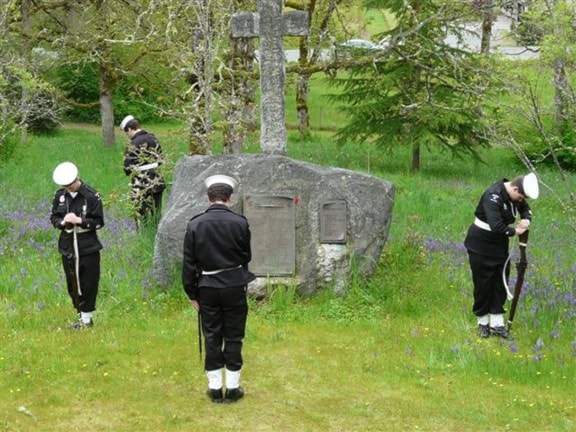“The sinking sunrays tinged the grey sky with roseate hues, lighting the great stone of remembrance, and breathing a message of hope to those who laid on it their floral tributes”. —Cowichan Leader
As the least visible of Cowichan’s five war memorials, the massive chunk of granite that honours St. Peter, Quamichan’s war dead is also the least known for all its having been there for just under a century.
It was dedicated in November 1919 in what was described as a simple ceremony which “recalled anew Cowichan’s part in the Great War and the price which so many of her sons were called on to pay”.
Simple ceremony, perhaps, but one filled with poignancy, the Cowichan Leader noting that, of the “many heartrending scenes [that] have been enacted here...none could have been more touching than that of those of last Sunday”.
Of the full house in attendance, half the seats were occupied by families and friends of the fallen. Outside, another 400 persons, not all of them parishioners of St. Peter’s, “ranged themselves about the great cross which faces the southern entrance of the church” as a westerly wind, crying seagulls and gathering clouds gave promise of rain and moved the Leader to near-eloquence: “The sinking sunrays tinged the grey sky with roseate hues, lighting the great stone of remembrance, and breathing a message of hope to those who laid on it their floral tributes”.
The impending change of weather prompted Rev. F.L. Stephenson to tighten up the program; to this end he was fortuitously aided by the unavoidable absence of Canon Leakey and Rev. Christmas. Rev. R.D. Porter, Chemainus, read the lessons, 1 Kings 8, 54-62 and John 15, 1-14 and the 46th Psalm and, after the hymns Soldiers who are Christ’s below and How bright these glorious spirits shine, the Bishop of Columbia addressed the assembly from the text Hebrews 11, 40.
He spoke of the last great German offensive in 1918 when, at a time that the Allies “had their backs to the wall,” a wondrous apparition was seen in the heavens: “a noble army of those who in many ages had lived and died to right wrongs. With their Master they came and the witness realized that was the time and hour when God offered him the opportunity of passing into such a circle.” This was no wild dream of a frightened soldier, declared the Bishop, but “the inspiration of many a one in the hour of great trial in the war”. Those who had gone before “were ours for inspiration; we were theirs for imitation”. This, he said, was the true meaning of the dedication service that day.
After The Sign and Symbol of Thy Grace, a hymn written for the occasion by Mrs. Elkington, all those inside the church joined those without and, upon the tablet being unveiled, Rector Stephenson solemnly intoned the 48 names inscribed thereon. The bishop then consecrated the memorial thus: “To the glory of God and in grateful remembrance of the men and women from this valley, we bless and dedicate this memorial and assign it this permanent place in God’s acre.”
After further prayers and thanksgiving prayer the bishop announced benediction. The firing party, which had been standing with bowed heads and arms reversed, was called to attention and fired three volleys. The service ended with the sounding of The Last Post.
Families and friends then placed wreaths of laurels and flowers, one in the form of a regimental crest, and those from the IODE and the King’s Daughters.
Beneath “Lest We Forget,” the tablet, designed by E.B. McKay, is inscribed with a cross on a mound between two field pieces and the monograms C.E.F. (Canadian Expeditoniary Force) and B.E.F. (British Expeditonary Force). Below, beneath the words “Pro Patri Mort” and the monograms, “R.N.” and “R.C.N.,” the 48 names. Unlike the names on the Duncan Cenotaph which give initials only, those of St. Peter’s also give the Christian names to which have been added those of the 10 St. Peter’s casualties of the Second World War.
The granite boulder, estimated to weigh 11 tons, had had to be hauled by teams of horses on a stone boat; this noble labour of remembrance took the volunteer labourers six days of herculean effort to cover a distance of a mile and a half! Something more for us to remember — not just on Remembrance Day.
www.twpaterson.com
